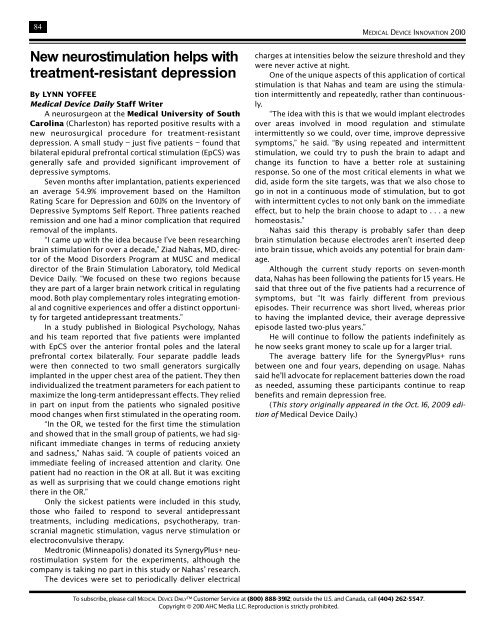MEDICAL DEVICE INNOVATION - Medical Device Daily
MEDICAL DEVICE INNOVATION - Medical Device Daily
MEDICAL DEVICE INNOVATION - Medical Device Daily
You also want an ePaper? Increase the reach of your titles
YUMPU automatically turns print PDFs into web optimized ePapers that Google loves.
84<br />
New neurostimulation helps with<br />
treatment-resistant depression<br />
By LYNN YOFFEE<br />
<strong>Medical</strong> <strong>Device</strong> <strong>Daily</strong> Staff Writer<br />
A neurosurgeon at the <strong>Medical</strong> University of South<br />
Carolina (Charleston) has reported positive results with a<br />
new neurosurgical procedure for treatment-resistant<br />
depression. A small study – just five patients – found that<br />
bilateral epidural prefrontal cortical stimulation (EpCS) was<br />
generally safe and provided significant improvement of<br />
depressive symptoms.<br />
Seven months after implantation, patients experienced<br />
an average 54.9% improvement based on the Hamilton<br />
Rating Scare for Depression and 60.1% on the Inventory of<br />
Depressive Symptoms Self Report. Three patients reached<br />
remission and one had a minor complication that required<br />
removal of the implants.<br />
“I came up with the idea because I’ve been researching<br />
brain stimulation for over a decade,” Ziad Nahas, MD, director<br />
of the Mood Disorders Program at MUSC and medical<br />
director of the Brain Stimulation Laboratory, told <strong>Medical</strong><br />
<strong>Device</strong> <strong>Daily</strong>. “We focused on these two regions because<br />
they are part of a larger brain network critical in regulating<br />
mood. Both play complementary roles integrating emotional<br />
and cognitive experiences and offer a distinct opportunity<br />
for targeted antidepressant treatments.”<br />
In a study published in Biological Psychology, Nahas<br />
and his team reported that five patients were implanted<br />
with EpCS over the anterior frontal poles and the lateral<br />
prefrontal cortex bilaterally. Four separate paddle leads<br />
were then connected to two small generators surgically<br />
implanted in the upper chest area of the patient. They then<br />
individualized the treatment parameters for each patient to<br />
maximize the long-term antidepressant effects. They relied<br />
in part on input from the patients who signaled positive<br />
mood changes when first stimulated in the operating room.<br />
“In the OR, we tested for the first time the stimulation<br />
and showed that in the small group of patients, we had significant<br />
immediate changes in terms of reducing anxiety<br />
and sadness,” Nahas said. “A couple of patients voiced an<br />
immediate feeling of increased attention and clarity. One<br />
patient had no reaction in the OR at all. But it was exciting<br />
as well as surprising that we could change emotions right<br />
there in the OR.”<br />
Only the sickest patients were included in this study,<br />
those who failed to respond to several antidepressant<br />
treatments, including medications, psychotherapy, transcranial<br />
magnetic stimulation, vagus nerve stimulation or<br />
electroconvulsive therapy.<br />
Medtronic (Minneapolis) donated its SynergyPlus+ neurostimulation<br />
system for the experiments, although the<br />
company is taking no part in this study or Nahas’ research.<br />
The devices were set to periodically deliver electrical<br />
<strong>MEDICAL</strong> <strong>DEVICE</strong> <strong>INNOVATION</strong> 2010<br />
charges at intensities below the seizure threshold and they<br />
were never active at night.<br />
One of the unique aspects of this application of cortical<br />
stimulation is that Nahas and team are using the stimulation<br />
intermittently and repeatedly, rather than continuously.<br />
“The idea with this is that we would implant electrodes<br />
over areas involved in mood regulation and stimulate<br />
intermittently so we could, over time, improve depressive<br />
symptoms,” he said. “By using repeated and intermittent<br />
stimulation, we could try to push the brain to adapt and<br />
change its function to have a better role at sustaining<br />
response. So one of the most critical elements in what we<br />
did, aside form the site targets, was that we also chose to<br />
go in not in a continuous mode of stimulation, but to got<br />
with intermittent cycles to not only bank on the immediate<br />
effect, but to help the brain choose to adapt to . . . a new<br />
homeostasis.”<br />
Nahas said this therapy is probably safer than deep<br />
brain stimulation because electrodes aren’t inserted deep<br />
into brain tissue, which avoids any potential for brain damage.<br />
Although the current study reports on seven-month<br />
data, Nahas has been following the patients for 1.5 years. He<br />
said that three out of the five patients had a recurrence of<br />
symptoms, but “It was fairly different from previous<br />
episodes. Their recurrence was short lived, whereas prior<br />
to having the implanted device, their average depressive<br />
episode lasted two-plus years.”<br />
He will continue to follow the patients indefinitely as<br />
he now seeks grant money to scale up for a larger trial.<br />
The average battery life for the SynergyPlus+ runs<br />
between one and four years, depending on usage. Nahas<br />
said he’ll advocate for replacement batteries down the road<br />
as needed, assuming these participants continue to reap<br />
benefits and remain depression free.<br />
(This story originally appeared in the Oct. 16, 2009 edition<br />
of <strong>Medical</strong> <strong>Device</strong> <strong>Daily</strong>.)<br />
To subscribe, please call <strong>MEDICAL</strong> <strong>DEVICE</strong> DAILY Customer Service at (800) 888-3912; outside the U.S. and Canada, call (404) 262-5547.<br />
Copyright © 2010 AHC Media LLC. Reproduction is strictly prohibited.
















